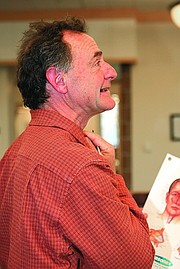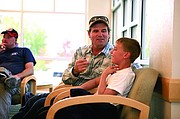A lil' backcountry ingenuity
r. Michael Righetti’s day job prepares him pretty well for the unexpected medical emergencies he may encounter as a backcountry horseman. The St. Joseph’s Medical Center orthopedic surgeon knows that a little ingenuity can go a long way when limited resources and wilderness isolation force you to think outside the box to save a life.
Righetti gave a free two-hour presentation to the public on Wed. Sept. 15, so that they could learn a thing or two as well. The Wilderness First Aid seminar built on Righetti’s previously conducted Survival Skills seminar, which emphasized the priorities of shelter, water, food, fire and signal. The most important thing, he said, was “do not panic!”
According to Righetti, a person can survive for three minutes without air, three hours without shelter, three days without water and three days without food. Based on those numbers, he opened the presentation with a “handy dandy safety pin” lesson.
Since an unconscious person is most likely to suffocate because they are choking on their own tongue, how do you remove it, he asked?
While the solution garnered a few grimaces from the audience, it proved to be a far easier solution than anyone had imagined.
“Put a safety pin through their tongue,” he said. “Pin it to their cheek or shirt. They’re unconscious, the can’t feel it and you will save their life.”
With a few safety pins in your medical kit, Righetti continued to show skeptics how to get out of a number of sticky situations, including how to make a triangular bandage with a single safety pin and create a sling by simply pinning two sections of a person’s shirt together.
“What happens when that rock falls from under your friend’s feet?” he asked the audience. “What do you do if a rock slices your friend’s head?”
Did you know you can close a scalp laceration with a little bit of string and a person’s own hair?
“We’re here to be innovative,” he said. “So if you get into a bind you can think, ‘Hey, I’ve heard that before!’”
By the event’s conclusion, attendees had been introduced to: Wound management (ways to stop bleeding and prevent infection); splinting broken bones (with natural debris, a sleeping pad or a specialized Sam’s Splint); and creating traction on the injury to reduce pain and provide stability (hang a water bottle from an arm or tie limb to tree, scoot back six inches and lay down).
“Irrigation is the solution” to excessive blood loss he said, “it dilutes the bacteria.”
Victims should drink salty water or Gatorade to replace the lost blood and electrolytes. When washing out a wound, hold the water bottle higher to create pressure for a more thorough cleaning. Items like sunscreen, lip balm and sunglasses can prove invaluable on outdoor adventures, especially on glacier travel, or in snow.
“Eyeware loss is devastating,” Righetti said. “But, you can create sunglasses by wrapping cloth or slotted duct tape around your eyes.”
A ball point pen can come in handy for writing down emergency information, a note to rescuers, or even as a cricothyrotomy tube, if the situation deteriorates to a last resort. According to Righetti, it is not entirely uncommon for people to get kicked in the throat when riding horses into the backcountry.
“I always carry a tube with me,” he said. “I will probably never use it, but I have it just in case.”
Thirteen-year-old Alex Salois, of Polson, was one of a handful of youth in attendance. Already an avid outdoorsman, Salois came to the presentation in order to bolster his background for hunting. He seems to be well prepared, having already taken certification course in Cardiopulmonary Resuscitation (CPR) and Automated external defibrillator (AED), although he “doubts I’ll have one of those out there.”
Salois played the role of Righetti’s right hand man during the presentation. He volunteered his hand for a hypothetical broken finger-taping demonstration and his leg for the doctor to illustrate tying an ankle brace to create traction. Finally, as the last activity of the evening, Salois allowed Righetti and Dave Crawford, a backcountry horseman from Ronan, tie him to a make-shift rescue stretcher. The two piled blankets, between two poles, then secured their victim tightly to the contraption with a series of strategic knots from head to toe.
In a real camping situation, Righetti told onlookers to use whatever they can, including sleeping pads, jackets, ski poles, or sticks to get the job done. It doesn’t have to be pretty, it just has to work.
He said since it can take eight people to carry a person out of the backcountry on a stretcher. Assessing the situation, a better use of time and resources could be to hike out and call for help, depending on how far into the wild the incident takes place.
Presentation attendees were thankful to Righetti for his insight, and most felt better prepared for their next trip to the backcountry.
“I can add some of this to my bag of tricks,” Polson Volunteer firefighter and Polson/Ronan Emergency Medical Technician Jason Whealon said.
EMTs received credit hours for their participation in the roughly two-hour event. For Whealon, however, the idea of thinking outside the box is not new.
“I’ve already had to do things like this on three hunting trips to get friends out of the backcountry,” he said. “You never know when something bad will happen.”





